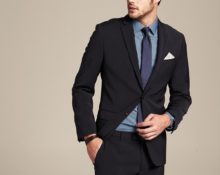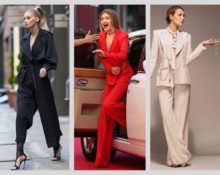The term “business attire” did not appear immediately. At first, office workers simply had to dress more modestly and simply. Today it is a whole fashion industry, which occupies a separate niche in the production of clothing, shoes, and accessories. Each element of the business image is carefully thought out and “works” in harmony with all the others.
What is business style in clothing?
The office dress code did not appear yesterday. Back in the middle of the last century, people began to think about what an employee should look like. And if everything is more or less clear with a man, then when choosing women's clothing in a business style, you can encounter problems. What elements should be present in a business woman's wardrobe? How is the taboo prescribed? A number of these issues are still being analyzed.
The main thing in a modern woman’s business closet is a suit with a mandatory jacket and trousers or a skirt.
It is worth noting that classic and business looks are slightly different things. Purely classic clothes are strict lines, length, restrained basic colors and high-quality fabrics, while the pieces are designed to be combined with almost any other clothing. This is especially true today, in times of eclecticism and mixing of shapes, textures, fabrics, and styles. A business wardrobe is also characterized by these features, but with only one difference - you can wear such things exclusively to the office.
Business style in women's clothing is aboutmandatory adherence to the dress code of your enterprise, compliance with the laws of combinations in ensembles, shoes, accessories. This also includes:
- elegance and nobility of rather strict styles;
- expensive clothing fabrics and shoe materials;
- absence of tackiness, “screaming”, vulgarity;
- no open shoes, flirty handbags;
- makeup and manicure mainly in nude style;
- decorations are expensive, but laconic and in minimal quantities.
In addition, a person in business attire represents his institution, he is its face, and the lion's share of success depends on how positive the initial external impression is at negotiations or meetings. Hairstyle, makeup, manicure, shoes must also match.

@luxe.digital
What is prohibited?
Business style requires a strict dress code and does not accept:
- jeans;
- shorts;
- shortened and tapered trousers;
- shoes with “open” toes and heels;
- skirts above the knees and bell-bottoms;
- transparent, lacquered fabrics, materials with lurex and similar inclusions;
- deep neckline, slits exposing the body;
- sports items of clothing and footwear;
- large cheap accessories, including jewelry;
- knitted items in sports styles;
- leather elements.

@pinterest.com
Business genre - types
Each enterprise creates its own set of laws regulating the style of clothing.And although it can be called business, in most cases certain relaxations in the formation of images are allowed. Depending on this, the genre in question can be divided into several directions.
Strict
Considered the most binding and formal. Most often, such a dress code is prescribed in banks, government agencies, and organizations working in the field of jurisprudence. It assumes the presence of a suit (trouser, skirt or with a dress) in the strictest traditions of the genre. Nuances:
- white blouse;
- solid color - black, gray, white, dark blue;
- no drawings, prints, decorations;
- closed shoes with low heels;
- the jacket covers the hips, the skirt and dress cover the knees;
- trousers of classic length and width;
- nude tights without lycra - always, even in summer;
- neat hairstyle with collected hair;
- classic small watch without decorations;
- stud earrings (studs) without stones and small size.

@freepik.com
Casual
The dress code is within the business genre, but without some restrictions. It is not necessary to follow strict laws, but it is necessary to look formal, businesslike.
For business casual, bright prints, short items that expose the body, T-shirt jersey, denim fabrics (especially jeans with holes), sportswear, and inappropriate shoes are also unacceptable. But in general this style allows a lot; here it is quite possible to realize oneself and express individuality with the help of clothes.

@thebalancecareers.com
Informal
Business style devoid of rigor, but necessarily within the “costume” genre. This means that here you can relax a little and add other things to your look, interesting, discreet accessories, make your makeup a little brighter, for example.
You shouldn’t go overboard and wear boyfriend jeans to the office, but a pencil skirt can be made of leather, the heels can be high, you can wear a badlon under a blazer, and a large glamorous handbag will come in very handy.

@dreamstreamind.blogspot.com
Managerial
Some thin the line between a strict dress code and details, acceptable in casual and informal settings - and this is the basis on which this style rests. Only a company owner, manager, or director can afford to dress like this. Business style is required here, but in some cases you can allow yourself A little brighter lipstick, a little deeper neckline, a little higher heel. In general, this depends on the company’s regulations, and in each individual case everything is considered individually.
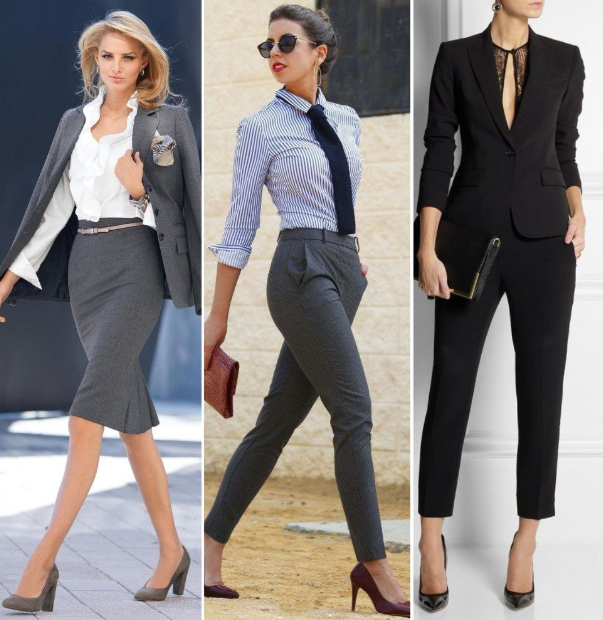
@twitter.com
Laws of style in a modern look
- Costume – a must-have item in a business wardrobe. And it's better if he's not alone. Based on a skirt or trouser set, you can create different sets for every day, depending on the severity of the prescribed dress code.
- Shoes Preferably made of matte leather in neutral shades. With strict regulations - black, less official - white, milky, beige, brown. In relaxed versions, dark blue, wine-colored is allowed. Printed models are examined under a microscope. Simple styles are preferred, without decoration or decoration.
- Tights – an important component of a business image in skirt ensembles. With a strict dress code, a matte pair must always be present. In other options the issue is discussed.
- In the office it is customary (or regulated) to wear closed-toe shoes. If the style is less formal, you can bare the heel. Bare toes are often taboo.No - wedges, platforms, high stilettos, cowboy heels. The latter should be average - 5–7 centimeters.
- Hairstyle neat, hair collected in a bun or ponytail. Curls, stray, loose or dirty strands, and split ends are not allowed.
- Makeup preferred in nude style. This is a “transparent” make-up, which implies its absence. The technique is so invisible that it creates the impression of naturalness and naturalness. In this case, it is necessary to hide skin defects, use a minimum of bright colors and neat eyebrows are required.
- Manicure exclusively in classic pastel colors. The stricter the dress code, the closer to natural the color of the marigolds should be. Current tones will be nude, delicate pink, discreet French, for example. No nail design.
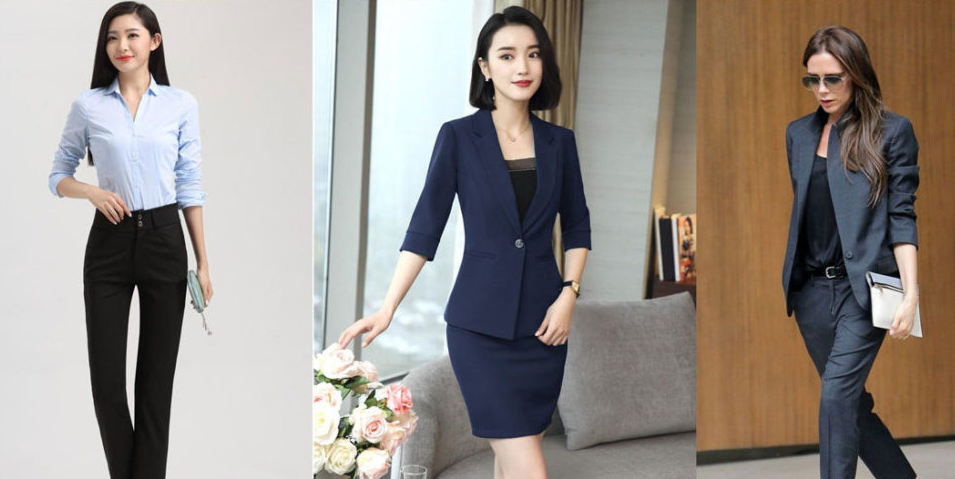
@myjestik.blog
Colors, prints, materials
Recommended classic colors black, white, beige, grey, brown, blue. Popular dark blue and maroon for his formality and relaxation at the same time. The remaining shades can be used carefully in informal looks.
Subtle classic prints are allowed, such as check, chopped check, houndstooth, stripe, polka dots.
However, permission to use such drawings should be clarified in the regulations.
Clothing must be chosen made from high-quality fabrics, smooth, with a matte texture. Varnish, lurex, gloss, and translucent materials are not allowed. It is better to look for styles without narrowing or fitting, and also avoid flounces, ruffles, and bows.

@pinterest.com
Wardrobe for a business woman
Any business closet has a base and details that highlight it. The base usually consists of:
- loose dress pants;
- pencil or a-line skirt;
- sheath dress;
- blazer;
- vest;
- white shirt/blouse.
For a less strict dress code, you can add cashmere sweater, badlon, shirtdress, business sundress, pullover, cardigan. And of course, less formal items of basic styles. Shoes recommended pumps, low-heeled ankle boots and matching boots. And of course, sets of these things.
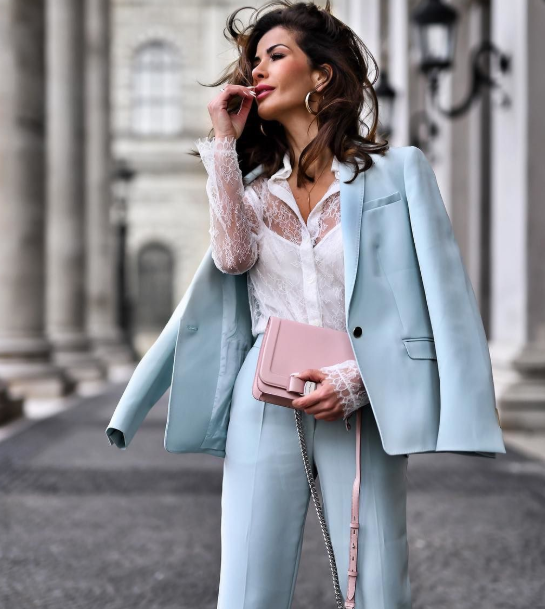
@confettissimo.com
Different seasons require different styles and fabrics:
- In summer It is recommended to choose clothes made from thin materials - xlOpka, crepe, opaque chiffon, linen, viscose. More dense - for skirts, trousers, for tops - thin, maximum breathable items.
- in winter Wool, tweed, cashmere, drape (the latter for outerwear) are preferred. Blouses and shirts are made of twill material, thick cotton, wool and silk. With a relaxed dress code, you are allowed to wear a cashmere badge or pullover underneath.
- IN off-season The same materials are possible, but you need to choose depending on the weather.


 0
0
